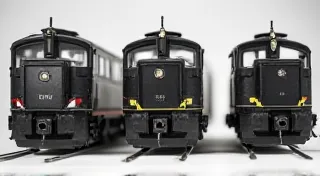Choosing the Right Scale for Your Model Railroad: HO vs. N vs. O
Embarking on the exciting world of model railroading? One of the very first, and arguably most important, decisions you'll make is choosing the right scale for your layout. It's more than just picking a size; it dictates the space required, the level of detail you can achieve, and the availability of locomotives and rolling stock. This article will break down three of the most popular scales – HO, N, and O – to help you determine which one best suits your needs and aspirations.
Understanding Model Railroad Scales
Model railroad scales aren't about literal size; they represent a ratio between the model and the real thing. Common scales include HO (1:87), N (1:160), and O (1:48). Let's look at each in detail.
HO Scale (1:87) - The Popular Choice
HO scale is, by far, the most popular scale in North America and Europe. It offers a good balance between detail and space requirements. You can achieve a decent level of detail in locomotives and rolling stock, and there's an enormous selection of products available from countless manufacturers. The track is generally robust and easy to work with, making it an excellent choice for beginners.

Pros of HO Scale:
- Wide variety of locomotives, rolling stock, and scenery available.
- Good balance between size and detail.
- Relatively easy to work with.
- Large community support and resources.
Cons of HO Scale:
- Requires a significant amount of space for a realistically sized layout.
- Can be more expensive than smaller scales.
N Scale (1:160) - Compact and Detailed
N scale is significantly smaller than HO, allowing you to fit a surprisingly detailed layout into a smaller space. This is a major draw for those with limited room. While detail has improved dramatically in recent years, it's still generally less detailed than HO scale. The smaller size also makes working with the track and trains a bit more challenging.
Pros of N Scale:
- Compact size - perfect for smaller spaces.
- Increasingly detailed locomotives and rolling stock.
- Good variety of products, though less than HO.
Cons of N Scale:
- Smaller size can be challenging to work with.
- Less detail than HO scale.
- Can be more fragile.

O Scale (1:48) - The Larger, More Imposing Choice
O scale offers the most detail and realism of these three scales. The larger size allows for incredible detail in locomotives and rolling stock, and it's a favorite among those who prioritize a highly realistic and visually impressive layout. However, O scale requires a *lot* of space, and it's typically the most expensive option.
Pros of O Scale:
- Highest level of detail and realism.
- Impressive visual impact.
- Large, robust locomotives and rolling stock.
Cons of O Scale:
- Requires a significant amount of space.
- Most expensive option.
- Fewer product options compared to HO and N scales.

Making Your Decision
Choosing the right scale is a personal decision. Consider these factors:
- Space Available: This is often the biggest limiting factor.
- Budget: Smaller scales are generally less expensive.
- Desired Level of Detail: How important is realism to you?
- Experience Level: HO scale is often recommended for beginners.
Ultimately, the best scale is the one that inspires you and allows you to enjoy the rewarding hobby of model railroading!





